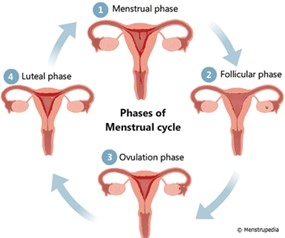Ladies, have you ever wondered why some days you absolutely smash it in the gym and the next week those same weights leave you feeling exhausted? There are many contributing factors to this including sleep, nutrition, recovery time, and your menstrual cycle. Given that your cycle is driven by hormonal changes, there are a lot of moving parts when it comes to your cycle.
Your hormones during your cycle are constantly fluctuation. This includes hormones such as:
- Oestrogen – the primary sex hormone in females. Oestrogen has a multitude of functions in the body but is involved in cardiovascular and bone health, cognition, and of course, reproductive health.
- Progesterone – helps to thicken the uterine lining, when your progesterone levels drop, this is when your period begins.
- Follicle-stimulating hormone (FSH) – helps follicles (the part that holds the eggs) in the ovaries mature.
- Luteinising hormone – stimulates ovulation.
Phases of the Menstrual Cycle
When breaking the cycle down, there are two main phases, the follicular phase, and the luteal phase.
Phase 1. Follicular Phase (1-14 days)
Your period begins at day one, and at day 14 (depending on your individual cycle), ovulation occurs where the egg is released from the follicle. Throughout this phase, oestrogen levels are high, and progesterone is lower. This is the phase where your energy and mood are higher.
During this phase you can try to maximise your strength benefits by:
- Increasing you weights and lowering your reps
- Including exercises that target multiple muscle groups in one movement such as squats, deadlifts, bench press, or equivalent variations
- Aim to use this ‘2-week’ window to improve strength and muscle mass
Some studies show, however, that you may need more rest time during this time as it has been suggested that women may be more prone to overtraining and increased muscle damage during this phase.
Phase 2. Luteal Phase (15-28 days)
Following ovulation when the egg is released, there is a rise in progesterone which triggers the thickening of the uterine wall. Oestrogen levels will drop dramatically during this time but will gradually increase over the next 14 days leading back up to the follicular phase. During ovulation there is a rise in core body temperature and the increase in progesterone increases resting heart rate and breathing rate. All these symptoms can increase strain on the body during exercise. Progesterone also has a catabolic effect which can reduce muscle protein synthesis which is essentially the muscle building process.
During this time, your training may look a little different:
- Decreased weights and increased reps to move into an endurance repetition range (12-20+)
- Maintain rest days between sessions if required
- Use this time to focus on other forms of training including aerobic endurance, mobility, Pilates, or yoga.

It is important to listen to your body, maintaining consistency will be far more beneficial in the long term than trying to push through fatigue and other symptoms or pushing too hard in the gym and not being able to recover as well. The menstrual cycle is very individual and therefore this information may not ring exactly true for everyone based on cycle length, specific symptoms, or if on hormonal birth control. This will also change depending on the type of training whether that is resistance training or aerobic training. It is also important to consider that sleep habits and nutrition may also need to change around the time of your period so be sure to talk to your GP, get a dietician on board, and talk to your Accredited Exercise Physiologist or Exercise Scientist to maximise your training.




